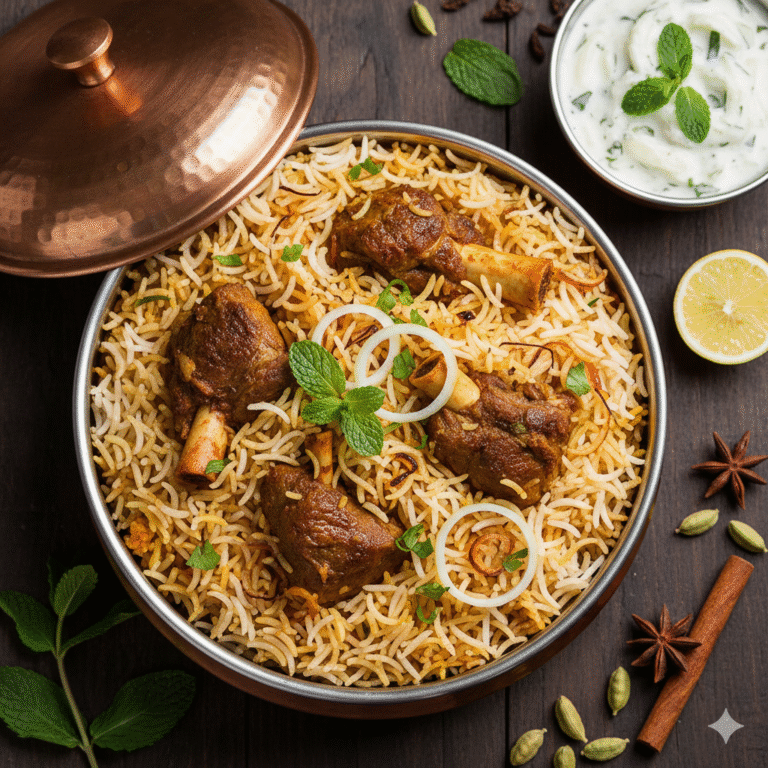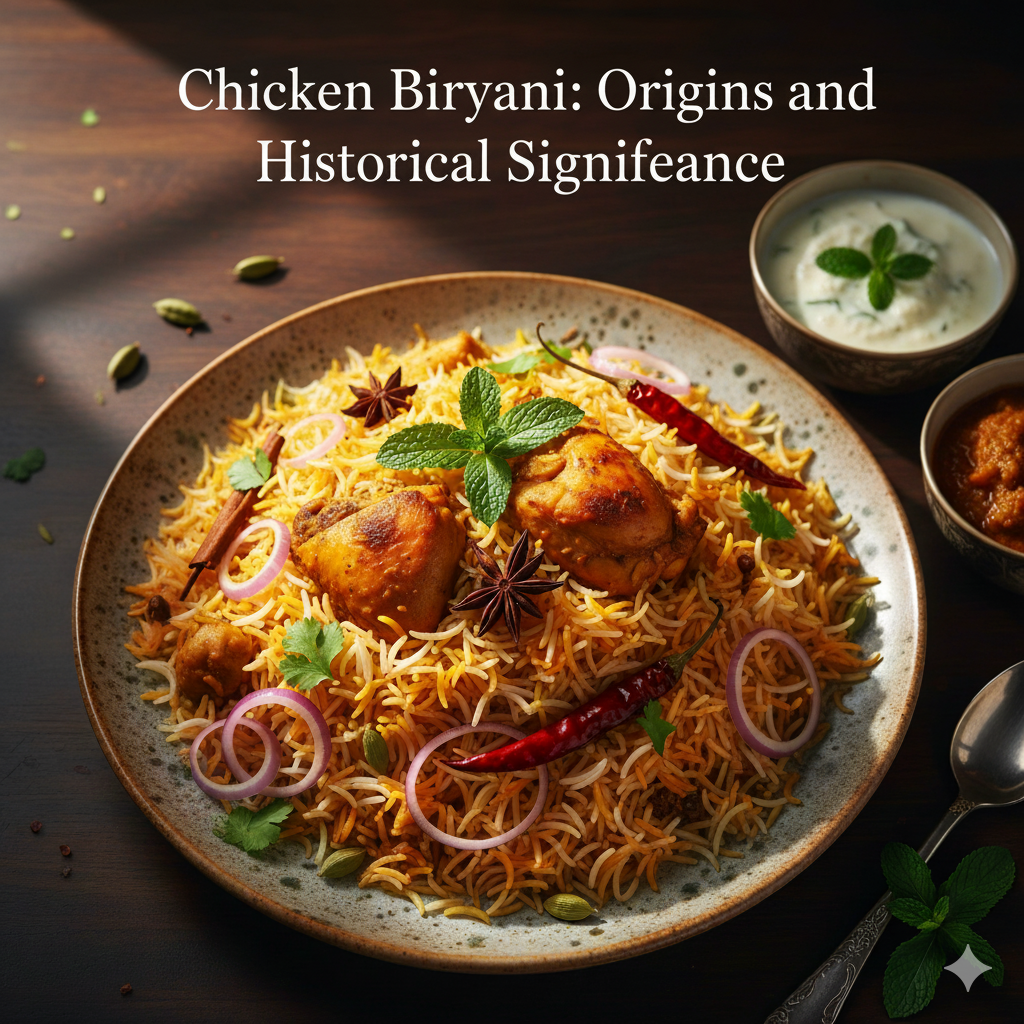The Ultimate Guide to Delicious Mutton Biryani: A Culinary Masterpiece of Flavor and Tradition

Table of Contents
Mutton Biryani is a dish that embodies the soul of Indian cuisine—a fragrant, spice-infused rice dish layered with tender mutton, crafted with love and precision. Known for its rich flavors and cultural significance, Mutton Biryani is a favorite at celebrations, family gatherings, and restaurants worldwide. In this 2500–3000-word guide, we’ll explore the origins, preparation techniques, regional variations, nutritional aspects (including calories), and tips for making or finding the perfect Mutton Biryani. Whether you’re a home cook or a foodie searching for the best version, this blog is your ultimate resource.
What is Mutton Biryani?
Mutton Biryani is a layered rice dish that combines long-grain basmati rice, succulent mutton (typically goat or lamb), and a symphony of spices like saffron, cardamom, and cloves. Cooked using methods like dum (slow-cooking in a sealed pot) or kacchi (raw meat and rice cooked together), Mutton Biryani is a celebration of texture and taste. The dish’s hallmark is its ability to balance bold flavors with delicate aromas, making every bite a sensory delight.

The History of Mutton Biryani
The origins of Mutton Biryani trace back to Persia, where the term “birian” means “fried before cooking.” Brought to India by Mughal emperors, biryani evolved into a culinary art form, blending Persian techniques with Indian spices. Over centuries, Mutton Biryani became a staple in royal kitchens and festive feasts, with each region adding its unique twist. Today, it’s a symbol of hospitality and indulgence, served at weddings, Eid celebrations, and special occasions.
Why Mutton Biryani is Special
Unlike lighter proteins, mutton’s robust, gamey flavor makes Mutton Biryani a standout. The meat’s ability to absorb spices during slow cooking results in a dish that’s rich and deeply satisfying. Whether you’re savoring a Hyderabadi kacchi biryani or a Lucknowi pukki version, Mutton Biryani offers an experience that’s both luxurious and comforting.
How to Make Authentic Mutton Biryani at Home
Crafting Mutton Biryani at home is a labor of love, requiring quality ingredients, patience, and attention to detail. Below, we’ll break down the process, from selecting ingredients to mastering the dum technique.
Essential Ingredients for Mutton Biryani
To create a restaurant-quality Mutton Biryani, you’ll need:
- Mutton: 1 kg, preferably bone-in for enhanced flavor.
- Basmati Rice: 2 cups, aged for fluffy texture.
- Whole Spices: Cardamom, cinnamon, cloves, star anise, and bay leaves.
- Ground Spices: Turmeric, red chili powder, coriander powder, and garam masala.
- Herbs: Fresh mint and cilantro for layering and garnish.
- Saffron: Soaked in ¼ cup warm milk for color and aroma.
- Onions: 2 large, thinly sliced and fried until golden.
- Yogurt: 1 cup for marinating the mutton.
- Ghee: 4–5 tbsp for richness.
- Ginger-Garlic Paste: 2 tbsp for depth of flavor.
Step-by-Step Mutton Biryani Recipe
Step 1: Marinate the Mutton
- Clean and cut 1 kg of mutton into medium-sized pieces.
- In a large bowl, combine mutton with 1 cup yogurt, 2 tbsp ginger-garlic paste, 1 tsp turmeric, 1 tsp red chili powder, 1 tsp garam masala, and salt.
- Marinate for at least 4 hours, ideally overnight, to tenderize the meat and infuse flavors.
Step 2: Prepare the Rice
- Rinse 2 cups of basmati rice until the water runs clear to remove excess starch.
- Soak the rice for 30 minutes, then parboil with 2 bay leaves, 4 cloves, and 2 cardamom pods until 70% cooked. Drain and set aside.
Step 3: Cook the Mutton
- Heat 4 tbsp ghee in a heavy-bottomed pot.
- Fry 2 large sliced onions until golden brown. Remove half for garnishing.
- Add whole spices (2 cinnamon sticks, 4 cardamom pods, 4 cloves) and sauté until fragrant.
- Add the marinated mutton and cook on medium heat for 10–15 minutes.
- Pour in 1 cup of water, cover, and simmer for 45–60 minutes until the mutton is tender.
Step 4: Layer and Dum Cook
- In a heavy-bottomed pot, spread a layer of cooked mutton.
- Add a layer of parboiled rice, followed by saffron milk, fried onions, mint, and cilantro.
- Repeat the layers, ending with rice and garnishes.
- Seal the pot with dough or a tight lid and cook on low heat (dum) for 30–40 minutes.
- Let it rest for 10 minutes before serving.
Pro Tips for Perfect Mutton Biryani
- Bone-In Mutton: Bones enhance the dish’s flavor.
- Saffron Soak: Soak saffron in warm milk for 20 minutes for maximum aroma.
- Dum Seal: Use dough or a heavy lid to trap steam, ensuring even cooking.
- Resting Time: Allow the biryani to rest post-cooking to meld flavors.
These techniques ensure your Mutton Biryani rivals the best restaurant versions.
Calories and Nutritional Profile of Mutton Biryani
For health-conscious foodies, understanding the nutritional content of Mutton Biryani is key. The calorie count varies based on ingredients, portion size, and cooking method, but here’s a breakdown:
- Calories: A typical serving of Mutton Biryani (about 1 cup or 200–250 grams) contains approximately 600–800 calories. This includes:
- Mutton (200g): ~250–300 calories (depending on fat content).
- Basmati Rice (100g cooked): ~130–150 calories.
- Ghee (1–2 tbsp): ~100–200 calories.
- Spices, onions, and yogurt: ~50–100 calories.
- Protein: Mutton provides 25–30 grams of high-quality protein per serving, supporting muscle health.
- Carbohydrates: Basmati rice contributes 30–40 grams of carbs, offering energy.
- Fats: Ghee and mutton fat add 20–30 grams of fat, including healthy fats from ghee.
- Micronutrients: Spices like turmeric and cumin offer anti-inflammatory benefits, while herbs provide vitamins.
To reduce calories, use lean mutton, less ghee, or pair with a light raita. While Mutton Biryani is indulgent, it can fit into a balanced diet when enjoyed in moderation.
Regional Variations of Mutton Biryani
India’s diverse culinary landscape has birthed numerous styles of Mutton Biryani, each with distinct flavors and techniques.
Hyderabadi Mutton Biryani
Hyderabadi Mutton Biryani is renowned for its kacchi style, where raw marinated mutton and rice are cooked together in a sealed pot. The result is a deeply aromatic dish with tender meat and perfectly spiced rice. This version is a must-try for biryani lovers.
Lucknowi (Awadhi) Mutton Biryani
Lucknowi biryani is subtle, using rose water, kewra, and saffron for delicate flavors. The pukki style (pre-cooked meat layered with rice) ensures a refined taste, making it ideal for those who prefer milder spices.
Kolkata Mutton Biryani
Kolkata Mutton Biryani stands out with its inclusion of potatoes and boiled eggs, adding unique texture. The spices are lighter, and the rice is fluffier, reflecting Bengal’s culinary finesse.
Malabar Mutton Biryani
From Kerala, Malabar biryani uses short-grain rice and incorporates coconut milk for creaminess. It’s spicier, with a coastal flair, appealing to those who love bold flavors.
Mutton Biryani vs. Other Biryanis
While Mutton Biryani is a star, it’s often compared to chicken or vegetable biryani. Here’s how it stacks up:
- Flavor: Mutton’s rich, gamey taste outshines chicken’s milder profile, making Mutton Biryani more indulgent.
- Cooking Time: Mutton requires 45–60 minutes to cook, compared to 20–30 minutes for chicken.
- Occasion: Mutton Biryani is a festive favorite, while chicken biryani is more everyday.
- Texture: Mutton offers a heartier bite, ideal for special meals.
Finding the Best Mutton Biryani Near You
Craving Mutton Biryani but not up for cooking? Here’s how to find top spots:
- Food Apps: Use Zomato, Swiggy, or Yelp to locate restaurants with high ratings for Mutton Biryani.
- Read Reviews: Look for feedback on authenticity, spice levels, and meat quality.
- Ask Locals: Friends or community members can point you to hidden gems.
- Regional Focus: Seek restaurants specializing in Hyderabadi, Lucknowi, or Malabar cuisines for authentic Mutton Biryani.
Perfect Pairings for Mutton Biryani
Elevate your Mutton Biryani experience with these sides and drinks:
- Raita: A cooling yogurt side with cucumber or onion to balance spices.
- Mirchi ka Salan: A spicy, tangy gravy, perfect for Hyderabadi biryani.
- Salad: Sliced onions, tomatoes, and cucumbers with lemon.
- Drinks: Lassi, jaljeera, or buttermilk to complement the richness.
Health Benefits of Mutton Biryani
When enjoyed in moderation, Mutton Biryani offers nutritional perks:
- Protein: Mutton is rich in protein, aiding muscle repair.
- Antioxidants: Spices like turmeric and cloves have anti-inflammatory properties.
- Energy: Basmati rice provides sustained energy from complex carbs.
To make it healthier, opt for lean mutton and minimal ghee, and pair with fiber-rich sides.
Common Mistakes to Avoid When Making Mutton Biryani
Avoid these pitfalls for a flawless Mutton Biryani:
- Overcooking Rice: Parboil to 70% doneness to avoid mushiness.
- Under-Marinating: Mutton needs 4+ hours to absorb flavors.
- Weak Dum Seal: A tight seal is essential for steam infusion.
- Skimping on Spices: Balance whole and ground spices for authentic taste.
Mutton Biryani for Festive Occasions
Mutton Biryani is a centerpiece at weddings, Eid, and family gatherings, symbolizing hospitality and celebration. Its elaborate preparation and rich flavors make it perfect for special moments.
FAQs About Mutton Biryani
Is Mutton Biryani spicier than other biryanis?
The spice level varies by recipe and region. Hyderabadi Mutton Biryani can be fiery, while Lucknowi is milder.
How long does it take to cook Mutton Biryani?
Including marination, cooking, and dum, Mutton Biryani takes 2–3 hours.
Can I use lamb instead of goat?
Yes, lamb is a great substitute, though goat is traditional.
How can I reduce the calories in Mutton Biryani?
Use lean mutton, less ghee, and pair with low-calorie sides like raita.
Conclusion
Mutton Biryani is more than a dish—it’s a culinary journey that blends tradition, flavor, and artistry. From its Mughal roots to its regional variations, this dish captures the essence of Indian cuisine. Whether you’re mastering our detailed recipe at home or searching for top restaurants serving Mutton Biryani, this guide equips you with everything you need. With its rich taste, nutritional benefits, and cultural significance, Mutton Biryani is a dish that brings people together, one fragrant bite at a time.

